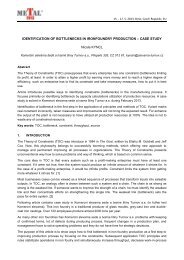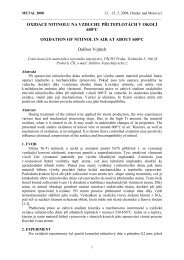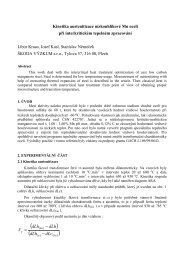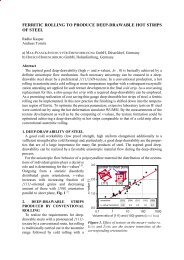development of indigeneous basic tundish powder for ... - metal 2013
development of indigeneous basic tundish powder for ... - metal 2013
development of indigeneous basic tundish powder for ... - metal 2013
You also want an ePaper? Increase the reach of your titles
YUMPU automatically turns print PDFs into web optimized ePapers that Google loves.
METAL 2003 20.-22.5.2003, Hradec nad Moravicí<br />
______________________________________________________________________________________<br />
TUNDISH METALLURGICAL PRACTICES FOR SLAB<br />
PRODUCTION IN BOKARO STEEL<br />
N. Banerjee, U. Vadvi, B.B. Reddy, D.S. Basu,<br />
R&D Centre <strong>for</strong> Iron & Steel, Steel Authority <strong>of</strong> India Limited, India<br />
E-mail: cast@rdcis.bih.nic.in<br />
Abstract<br />
The usage <strong>of</strong> <strong>basic</strong> <strong>tundish</strong> <strong>powder</strong> <strong>for</strong> slab casting <strong>of</strong> Low Carbon Aluminium<br />
Killed (LCAK) steels <strong>for</strong> deep drawing applications has become the recent trend in<br />
<strong>tundish</strong> <strong>metal</strong>lurgy. CaO-Al2O3-SiO2 system was considered <strong>for</strong> improving<br />
inclusion absorption in <strong>tundish</strong>. Melting characteristics <strong>of</strong> the <strong>powder</strong> were<br />
analysed to arrive at an appropriate composition <strong>for</strong> industrial application. Critical<br />
issues pertaining to product quality and caster operation were analysed <strong>for</strong> cold<br />
<strong>tundish</strong> practices in the Bokaro Steel Limited (BSL) <strong>of</strong> SAIL. Industrial data<br />
showed reduction in the inclusion volume fraction by over 45%. The study<br />
revealed considerable reduction in Al fading and silicon pick-up in steel.<br />
Operational issues such as thermal losses in <strong>tundish</strong> were tackled through<br />
properly controlling Loss On Ignition (LOI) <strong>of</strong> the <strong>powder</strong> in cold <strong>tundish</strong> practice.<br />
The paper describes various aspects relating to the <strong>development</strong> <strong>of</strong> <strong>tundish</strong><br />
<strong>metal</strong>lurgical practices.<br />
1.0 INTRODUCTION<br />
Inclusions have a deleterious effect on the per<strong>for</strong>mance <strong>of</strong> high quality steels,<br />
mainly flat products used in deep drawing operation. Due to customer demand<br />
and international competition, the thrust <strong>for</strong> producing cleaner steels free from<br />
inclusions is continuously increasing. As <strong>tundish</strong> provides one <strong>of</strong> the last<br />
opportunities to reduce the number <strong>of</strong> inclusions in the final product, it is being<br />
treated as a <strong>metal</strong>lurgical reaction vessel <strong>for</strong> improving steel quality. Different<br />
types <strong>of</strong> inclusions mainly oxides, which <strong>for</strong>m during various stages <strong>of</strong> steel, have<br />
a deleterious effect on mechanical properties, e.g. elongation, r bar, bend test etc.<br />
Separation <strong>of</strong> these inclusions is, there<strong>for</strong>e, very important <strong>for</strong> improving product<br />
quality. Tundish cover <strong>powder</strong>s play an important role in controlling thermal losses<br />
and separation <strong>of</strong> inclusions. Thus, the use <strong>of</strong> a suitable <strong>tundish</strong> <strong>powder</strong> is an<br />
essential feature modern <strong>tundish</strong> <strong>metal</strong>lurgical practice. However, the selection <strong>of</strong><br />
<strong>powder</strong> is specific to the grade <strong>of</strong> steel and product quality requirements. Basic<br />
concepts <strong>for</strong> the <strong>development</strong> <strong>of</strong> the <strong>basic</strong> <strong>tundish</strong> cover <strong>powder</strong> are described in<br />
the following section.<br />
The presence <strong>of</strong> reducible compounds viz.: SiO2 and FeO in <strong>tundish</strong> <strong>powder</strong> play<br />
an important role on steel cleanliness. Since the silica (SiO2) content <strong>of</strong> this<br />
<strong>powder</strong> is well over 92%, it remains in a solid state till 1500 o C. and thus the<br />
<strong>for</strong>mation <strong>of</strong> liquid slag in <strong>tundish</strong> at the interface with the steel is most unlikely.<br />
Lack <strong>of</strong> liquid slag layer hinders hermetic sealing <strong>of</strong> the steel against atmospheric<br />
oxygen, enabling oxygen absorption. Rice husk is conducive to another<br />
mechanism <strong>of</strong> reoxidation because SiO2 is not stable while casting Al killed steels.<br />
Dissolved Al in steel reduces silica present in <strong>tundish</strong> slag in accordance with the<br />
following reaction (1) .<br />
(SiO2) + 4/3 [Al] → 2/3 (Al2O3) +[Si] ------------- ( 1 )<br />
1
METAL 2003 20.-22.5.2003, Hradec nad Moravicí<br />
______________________________________________________________________________________<br />
a 2/3 (Al2O3) * a[Si]<br />
K = ----------------------- --------------- ( 2 )<br />
a (SiO2) * a 4/3 [Al]<br />
According to equation-1, silicon pick-up and Al fading will occur causing<br />
significant cleanliness deterioration <strong>of</strong> steel. The reoxidation reaction can be<br />
suppressed by lowering the silica or Al activity or by increasing the activity silicon.<br />
Figure 1 illustrates the changes in the silicon activity with the variation <strong>of</strong> SiO2 in<br />
<strong>tundish</strong> covering mass (1) . From the figure it is clear that if SiO2 content is<br />
restricted to less than 10%, the activity <strong>of</strong> SiO2 can be brought down to very low<br />
level thereby preventing the chance <strong>of</strong> reoxidation <strong>of</strong> steel as per eq.1. For<br />
fulfilling quality demands <strong>of</strong> critical products, low melting slags having potential to<br />
absorb alumina inclusions are being increasingly used in modern casting<br />
operations. But the extent to which a slag will fulfill the <strong>metal</strong>lurgical functions<br />
depends on its physico-chemical properties, which are mainly dependent on<br />
chemical and mineralogical composition.<br />
The best results achieved, so far, are with calcium aluminate (CaO-Al2O3-SiO2)<br />
slag (2) . These <strong>powder</strong>s are having low melting point, liquid at steel making<br />
temperature and have very high <strong>basic</strong>ity. As a result, the inclusion absorption<br />
capacity <strong>of</strong> these slags is very high. In addition due to quicker generation <strong>of</strong> liquid<br />
slags air ingress minimised leading to prevention <strong>of</strong> steel re-oxidation. Since these<br />
slags are more dense (>2.5 gm/cc) and more conductive, they pose certain<br />
operational difficulties namely thermal insulation and crust <strong>for</strong>mation.<br />
Figure-1: aSiO2 as a function <strong>of</strong> SiO2<br />
concentration in the CaO-Al2O3-SiO2<br />
system<br />
2<br />
Figure-2 : Crust <strong>for</strong>mation <strong>of</strong> <strong>tundish</strong><br />
As shown in Figure 2, crusting starts to occur at the top surface <strong>of</strong> the slag first<br />
and grows down because <strong>of</strong> thermal gradient (3) . In order overcome this problem<br />
<strong>of</strong> thermal insulation sand witch charging or double layer covering practice is<br />
followed. This practice enables improved per<strong>for</strong>mance these slags in terms <strong>of</strong><br />
thermal insulation and inclusion absorption. The effectiveness <strong>of</strong> these <strong>basic</strong><br />
<strong>powder</strong>s is further enhanced when used in combination with steel flow modifiers<br />
e.g. dams, weirs, baffles &, turbulence inhibitor (4) .<br />
Laboratory investigations on CaO-Al2O3-SiO2 system using Linz high temperature<br />
microscope slag were carried out to develop a suitable <strong>basic</strong> <strong>tundish</strong> cover<br />
material. Suitability <strong>of</strong> the <strong>powder</strong> was assessed through Industrial investigations<br />
in Bokaro Steel Limited (BSL). The <strong>powder</strong>s were suitably modified to cater their<br />
use in cold <strong>tundish</strong> applications being followed at BSL. The influence <strong>of</strong> flow<br />
control devices on the effectively <strong>of</strong> the <strong>powder</strong> was investigated. This paper
METAL 2003 20.-22.5.2003, Hradec nad Moravicí<br />
______________________________________________________________________________________<br />
describes detailed aspects pertaining to the <strong>development</strong> <strong>of</strong> <strong>basic</strong> <strong>tundish</strong> cover<br />
<strong>powder</strong>.<br />
2.0 EXPERIMENTAL :<br />
Development <strong>of</strong> the <strong>tundish</strong> <strong>powder</strong> was done through laboratory investigations to<br />
arrive at an appropriate composition. The effectiveness <strong>of</strong> these <strong>powder</strong>s on<br />
product quality was verified through industrial trials. Details <strong>of</strong> various<br />
investigations carried out are presented in the following sections:<br />
2.1 Laboratory investigations:<br />
CaO-Al2O3-SiO2 type slags were selected <strong>for</strong> laboratory investigations. The<br />
minerals viz.: calcite, calcined lime, pure Al2O3 and bauxite having chemical<br />
composition as shown in Table-1 were selected. These minerals were mixed in<br />
different proportions and samples having compositions as shown in Table.2 were<br />
made <strong>for</strong> characterisation <strong>of</strong> melting properties. The composition <strong>of</strong> the test<br />
samples was made in such a way that the slag has enough potential to absorb<br />
alumina inclusions. Care was taken to restrict the content <strong>of</strong> reducible compounds<br />
(SiO2 & Fe2O3) to well below 10% <strong>for</strong> minimising the reoxidation <strong>of</strong> steel. During<br />
the casting <strong>of</strong> LCAK steels, generation <strong>of</strong> alumina takes place and gets absorbed<br />
by <strong>basic</strong> <strong>tundish</strong> slags. This may reduce the CaO/Al2O3 ratio in the slag. In order<br />
counter this, CaO/Al2O3 ratio was kept well above unity in base <strong>powder</strong> so that the<br />
<strong>powder</strong> will remain in molten stage during entire casting operation.<br />
Table 1: Composition <strong>of</strong> ingredients<br />
Minerals % CaO % Al2O3 % MgO % SiO2 Fe2O3<br />
Calcite 99 --- --- --- ---<br />
Pure Al2O3 --- >98% --- --- ---<br />
Calcined<br />
lime<br />
88.36 1.20 --- 3.55 2.21<br />
Bauxite 0.81 77.13 --- 13.70 2.81<br />
Table 2: Mixing proportion & chemical analysis <strong>of</strong> <strong>basic</strong> slags.<br />
Sample Calcite, Bauxite, CaO Al2O3 SiO2 Fe2O3<br />
(%) (%) (%) (%) (%) (%)<br />
A 60 40 60 40 --- ---<br />
B 55 45 56.70 26.80 7.21 2.06<br />
C 65 35 60.67 24.56 6.28 2.56<br />
D 70 30 63.39 21.97 6.39 1.75<br />
Melting range <strong>of</strong> the <strong>powder</strong> is the most significant property <strong>of</strong> <strong>basic</strong> <strong>tundish</strong><br />
<strong>powder</strong> since the slag should remain liquid at steel making temperature to prevent<br />
re-oxidation and promote Al2O3 absorption. Measurement <strong>of</strong> melting range i.e.<br />
start <strong>of</strong> melting to end <strong>of</strong> melting <strong>of</strong> test <strong>powder</strong>s were carried out through Linze<br />
high temperature microscope at a heating rate <strong>of</strong> 10 dig C/min in inert atmosphere<br />
(N2). It was ensured that the test <strong>powder</strong>s should pass 90% below 200 mesh size<br />
during melting studies.<br />
2.2 Industrial Trials:<br />
Based on the laboratory investigations, a typical <strong>powder</strong> composition was<br />
selected <strong>for</strong> industrial trial. The trials were conducted in cold <strong>tundish</strong> at BSL. In<br />
3
METAL 2003 20.-22.5.2003, Hradec nad Moravicí<br />
______________________________________________________________________________________<br />
cold <strong>tundish</strong> practice the effectiveness <strong>of</strong> the <strong>powder</strong> with and without flow control<br />
device was investigated. Influence <strong>of</strong> the <strong>powder</strong> on various quality issues viz.:<br />
Inclusion absorption, Al fading, Silicon pick-up was analysed. Issues related to<br />
thermal losses and crust <strong>for</strong>mation in <strong>tundish</strong> were monitored <strong>for</strong> its effectiveness.<br />
3.0 RESULTS AND DISCUSSIONS:<br />
3.1 Tundish Powder Composition:<br />
Powder Composition <strong>of</strong> the <strong>basic</strong> flux is finalised based on characteristic<br />
temperatures, viz.: initial de<strong>for</strong>mation temperature (IDT), Half-Spherical<br />
Temperature (DST) and Fusion Temperature (FT). Fusion temperature and the<br />
melting range (FT-IDT) <strong>of</strong> the <strong>powder</strong> play an important role in identifying melting<br />
characteristics <strong>of</strong> the <strong>powder</strong>. Melting characteristics <strong>of</strong> the slag samples is<br />
presented in the Table-3.<br />
Table 3: Melting range <strong>of</strong> slags.<br />
Sample IDT ( o C) HST ( o C) FT ( o C)<br />
A 1280 1340 1480<br />
B 1105 1215 1235<br />
C 1160 1250 1280<br />
D 1155 1280 1340<br />
IDT: Initial de<strong>for</strong>mation temperature; HST: Half-Spherical Temperature; FT: Fusion Temperature<br />
As per the data shown in Table-3, Silica content and the ratio between CaO and<br />
Al2O3 play an important role on melt finish temperature <strong>of</strong> the CaO-Al2O3-SiO2<br />
slags. With the absence <strong>of</strong> SiO2 in the sample, the melt finish temperature<br />
reaches a maximum at 1480 o C, which is undesirable from the point <strong>of</strong> view <strong>of</strong><br />
early <strong>for</strong>mation <strong>of</strong> liquid slag pool in <strong>tundish</strong> leading to re-oxidation <strong>of</strong> steel in<br />
<strong>tundish</strong>. The presence <strong>of</strong> 5-6% SiO2 in slag (samples B, C & D <strong>of</strong> Table-3) led to<br />
the reduction <strong>of</strong> melting finish temperature compared to sample A. However<br />
higher content <strong>of</strong> silica and iron oxide in the slag is undesirable, <strong>for</strong> minimising<br />
reoxidation problems in <strong>tundish</strong>. Increase in CaO/Al2O3 ratio in the slag, led to<br />
increase the melting finish temperature <strong>of</strong> the slag.<br />
Thus based on the criteria <strong>of</strong> melt finish<br />
temperature (
METAL 2003 20.-22.5.2003, Hradec nad Moravicí<br />
______________________________________________________________________________________<br />
with the consequent reduction in inclusion volume fraction. This has resulted in<br />
increasing the cold reducibility <strong>of</strong> hot rolled coils to over 91%.<br />
Inclusion volume fraction, %<br />
0.5<br />
0.4<br />
0.3<br />
0.2<br />
0.1<br />
0<br />
0.45<br />
0.3<br />
0.17<br />
0.27<br />
0.16<br />
0.1<br />
0.33<br />
0.25<br />
0.16<br />
0.16<br />
0.14<br />
0.11<br />
5<br />
Figure-4: Influence <strong>of</strong> <strong>tundish</strong><br />
practice on steel cleanliness<br />
Table 4: Influence <strong>of</strong> <strong>basic</strong> <strong>tundish</strong> <strong>powder</strong> on steel cleanliness.<br />
Tundish cover practices<br />
Inclusion volume fraction<br />
Average, %<br />
Cold <strong>tundish</strong> practices with no baffle<br />
Range,%<br />
Silica 0.25 0.16 – 0.33<br />
Basic 0.14 0.11 – 0.16<br />
Cold & <strong>basic</strong> <strong>tundish</strong> practices with baffle<br />
Silica 0.18 0.14 – 0.22<br />
Basic 0.12 0.07 – 0.17<br />
0.22<br />
0.18<br />
0.14<br />
3.3 Al fading & Si-pick-up in <strong>tundish</strong> :<br />
The influence <strong>of</strong> <strong>basic</strong> <strong>tundish</strong> cover <strong>powder</strong> on Al fading and silicon pick-up <strong>of</strong><br />
steel in <strong>tundish</strong> play an important role <strong>for</strong> improving de<strong>for</strong>mation characteristics <strong>of</strong><br />
hot rolled LCAK steel coils. Industrial data pertaining to Al fading and silicon pickup<br />
is presented in Table-5. The data showed that the usage <strong>of</strong> calcium aluminate<br />
<strong>tundish</strong> flux reduced the extent <strong>of</strong> Al fading and silicon pick-up, in comparison to<br />
carburised rice husk. Al fading and silicon pick-up is mainly due to the reoxidation<br />
<strong>of</strong> <strong>tundish</strong> <strong>metal</strong> when comes in contact with the reducible oxides present in<br />
<strong>tundish</strong> slag. This has a direct influence on de<strong>for</strong>mation properties <strong>of</strong> steels.<br />
Table 5: Al fading & Si pick-up with different <strong>tundish</strong> fluxes<br />
Tundish cover Aluminium Loss, % Silicon pick-up,%<br />
<strong>powder</strong> type Average Range Average Range<br />
Rice husk 0.018 0.002-0.037 0.005 0.001-0.014<br />
Calcium-aluminate 0.011 0.001-0.029 Negligible Negligible<br />
3.4 Operational aspects with <strong>basic</strong> <strong>tundish</strong> slag :<br />
Since <strong>basic</strong> <strong>powder</strong> has low thermal insulation property due to its higher thermal<br />
conductivity in comparison to carburised rice husk, an optimum <strong>tundish</strong> <strong>powder</strong> is<br />
to be obtained by combining the advantages <strong>of</strong> <strong>basic</strong> <strong>powder</strong>s and insulation<br />
<strong>powder</strong>s. A double layer practice was there<strong>for</strong>e followed, wherein the addition <strong>of</strong><br />
0.17<br />
0.12<br />
0.07<br />
Acid flux Basic flux Acid flux Basic flux Acid flux Basic flux<br />
Hot <strong>tundish</strong> Cold <strong>tundish</strong> Cold <strong>tundish</strong>+buffle<br />
Tundish cover practice
METAL 2003 20.-22.5.2003, Hradec nad Moravicí<br />
______________________________________________________________________________________<br />
calcium aluminate flux was followed by carburised rice husk at the initial stages <strong>of</strong><br />
<strong>tundish</strong> filling.<br />
The loss on ignition (LOI) <strong>of</strong> the <strong>powder</strong> plays an important role in controlling<br />
thermal losses in <strong>tundish</strong>. Most importantly, the importance <strong>of</strong> LOI on thermal<br />
losses gets aggravated when cold <strong>tundish</strong> practices are followed. The cold<br />
<strong>tundish</strong> practices resulted in excessive thermal losses in <strong>tundish</strong> to the tune <strong>of</strong> 15 o<br />
C in the initial stages <strong>of</strong> casting when the <strong>basic</strong> <strong>powder</strong> with higher LOI <strong>of</strong> 10%<br />
was added. To overcome this problem <strong>of</strong> <strong>metal</strong> freezing in the initial stages <strong>of</strong><br />
casting, the calcined raw materials were pre-fused at 1400 o C be<strong>for</strong>e grinding and<br />
packing. The usage <strong>of</strong> these <strong>powder</strong>s with LOI <strong>of</strong>








